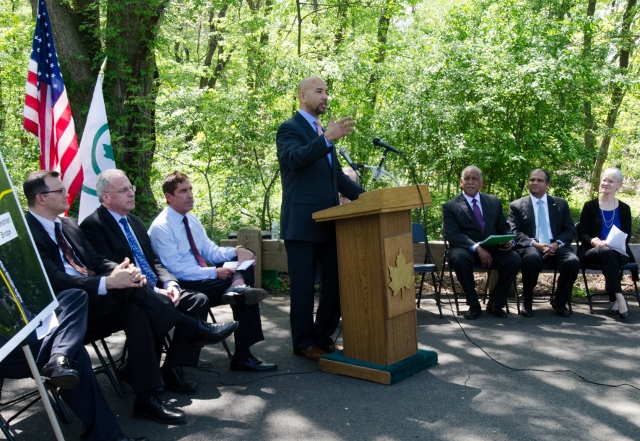
Photo by Jenny Sharp
By JANAKI CHADHA
Community advocacy for the building of a pedestrian bridge over the Major Deegan Expressway to connect the two sides of Van Cortlandt Park has gone on for over a decade. On May 8, community leaders and representatives announced $12 million has been allocated for the proposed bridge, thanks to collective efforts from community, city, and state officials.
“It’s a dream come true,” said Christina Taylor, executive director for the Friends of Van Cortlandt Park, one of many activists who worked towards seeing funding for the project through over the years.
“This park, as you all know, is truly a gem of the Bronx and this pedestrian bridge project will ensure that even more visitors have access to [it],” said Mitchell Silver, Commissioner of the city Department of Parks.
The bridge will be built just near exit 13 the Major Deegan Expressway North, which dissects the park. The New York City Department of Design and Construction will spearhead the project, which will also see the formation of a pathway connecting the east and west sides of Van Cortlandt Park.
The bridge is expected to be completed in 2019. The project culminates some swift action within the Albany Legislature, with Assemblyman Jeff Dinowitz convincing Assembly Speaker Carl Heastie to provide $3 million needed to build the bridge.
“This bridge will not only bring the park together but symbolically bring communities together, and I can’t think of anything more appropriate than doing that in this beautiful park,” said Dinowitz, whose entire district covers Van Cortlandt Park.
On the state Senate side, Senator Jeff Klein set aside $1 million to foot the remainder of the bridge.
Though this project was part of the original Van Cortlandt Park master plan, lack of funding had essentially delayed it. Councilman Andrew Cohen, whose entire district covers Van Cortlandt Park, was credited for prioritizing the reality of the bridge.
Borough President Ruben Diaz Jr. spoke about the importance of community activism in initiatives like this. “We have good leadership, leadership that listens,” he said. “Maybe it doesn’t happen at the exact time you want it to, but for those of you who have been activists, for those of you who are community leaders, for those of you who have been speaking your minds, continue to do so.”
Many have wondered why solidifying this project had taken so long. Diaz said this may not have happened had the current community, city and state representatives, namely Cohen, Heastie or Klein not been elected.
The timing of the project came just as officials with the New York City Department of Environmental Protection, which is using some funds to cover the cost of the bridge, quietly activated the long delayed Croton Water Filtration Plant, built underneath a portion of the park. Roughly 100 million gallons of water will flow through the plant daily, and to New York City homes. The bridge proposal was tied to a 2008 mitigation project linked to the building of the plant. DEP would ultimately conduct a feasibility study of the project.
Construction for the plant began in 2005. It was supposed to be completed in 2011 under a federal order, but was marred by the enormity of the project, which ultimately went $3 billion over budget.
“I would not gloat over a project built four times over budget,” said Dinowitz, a staunch critic of the plant. “It’s not something to be proud of.”




